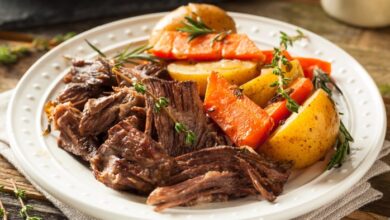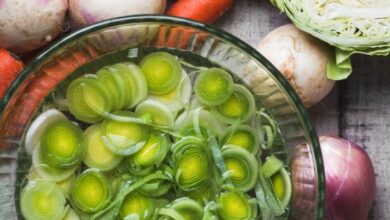
Roasted Leg of Pork: A Guide to Deliciousness
Roasted leg of pork is a classic dish that always impresses. From the crispy crackling to the juicy meat, it’s a feast for the senses. Whether you’re a seasoned chef or a beginner in the kitchen, this guide will walk you through everything you need to know to roast a perfect leg of pork.
We’ll delve into the anatomy of a leg of pork, explore different cuts, and provide tips for selecting the best piece for roasting. Then, we’ll cover roasting techniques, ensuring you achieve that coveted crispy skin and tender, juicy interior.
Of course, no roasted leg of pork is complete without flavor, so we’ll explore various flavor profiles, including traditional, herbed, and citrusy options. Finally, we’ll explore delicious side dishes, serving suggestions, and even creative ways to repurpose leftovers.
The Perfect Roast

A succulent roast leg of pork is a true culinary masterpiece, capable of transforming a simple meal into a feast for the senses. Whether you’re a seasoned chef or a novice in the kitchen, mastering the art of roasting a leg of pork is a rewarding endeavor.
This guide will equip you with the knowledge and techniques to achieve a tender, juicy, and flavorful roast that will impress even the most discerning palate.
Understanding the Anatomy of a Leg of Pork
The leg of pork, also known as the ham, is a versatile cut that offers a variety of options for roasting. It’s important to understand the different cuts available to make an informed choice for your culinary creation. The leg of pork is comprised of several distinct muscles, each with its own unique texture and flavor profile.
The most common cuts include:
- Whole Leg:This is the entire leg, including the shank, the knuckle, and the loin. It’s a large cut, perfect for feeding a crowd.
- Boneless Leg:This cut has the bone removed, making it easier to carve and serve. It’s also a good option for those who prefer a more tender roast.
- Center Cut:This cut is taken from the middle portion of the leg, resulting in a leaner and more tender roast. It’s ideal for smaller gatherings.
Selecting the Perfect Leg of Pork
Choosing the right leg of pork is crucial for a successful roast. Consider the following factors when selecting your cut:
- Size:The size of the leg of pork will determine how many people it can serve. A whole leg can easily feed 8-10 people, while a center cut is suitable for 4-6.
- Fat Content:The fat content of the leg of pork will affect the flavor and tenderness of the roast. A leg with a good amount of fat will be more flavorful and juicy, but it may also be higher in calories.
Look for a leg with a good balance of fat and lean meat.
The Importance of Brining or Marinating
Brining or marinating a leg of pork before roasting is a key step in achieving a moist and flavorful roast. Brining involves soaking the pork in a salt solution, which helps to retain moisture and enhance flavor. Marinating involves soaking the pork in a flavorful liquid, such as wine, vinegar, or citrus juice, which adds depth and complexity to the flavor profile.
A roasted leg of pork is a classic dish that’s always a crowd-pleaser. The crispy skin and juicy meat are irresistible, and the aroma that fills the kitchen as it cooks is simply divine. For a sweet and savory twist, I love to serve it alongside a side of cinnamon roll monkey bread.
The gooey, cinnamon-sugar goodness complements the richness of the pork perfectly, creating a meal that’s both satisfying and indulgent.
Brining Tip:For a basic brine, dissolve 1 cup of kosher salt in 1 gallon of cold water. Submerge the leg of pork in the brine for 12-24 hours, ensuring it’s fully submerged. After brining, pat the pork dry with paper towels before roasting.
Roasting Techniques and Temperature

Roasting a leg of pork is a classic culinary technique that yields succulent and flavorful results. Achieving the perfect roast, however, requires understanding the proper roasting techniques and maintaining the right temperature throughout the process. This section delves into the intricacies of roasting a leg of pork, focusing on the techniques for achieving a crispy skin and juicy interior.
Roasting Techniques for Crispy Skin and Juicy Interior
Achieving a crispy skin and juicy interior is the hallmark of a successful roast. This involves a combination of techniques, including proper preparation, basting, and temperature control.
- Scoring the Skin:Scoring the skin of the pork leg allows for greater surface area exposure, facilitating crisping during roasting. Use a sharp knife to make shallow cuts about 1/2 inch apart across the entire surface of the skin.
- Salt and Pepper:Seasoning the skin generously with salt and pepper enhances the flavor and helps to draw out moisture, leading to crispier skin.
- High Heat:Begin roasting the pork at a high temperature (450°F) for the first 30 minutes to encourage rapid browning and crisping of the skin. This initial high heat creates a protective layer that helps retain moisture in the meat.
- Lowering the Temperature:After the initial high-heat period, reduce the oven temperature to 325°F and continue roasting until the internal temperature reaches 145°F. This lower temperature ensures even cooking and prevents the meat from drying out.
- Basting:Basting the pork with pan drippings or a flavorful glaze during roasting helps to keep the meat moist and adds a rich flavor. Basting should be done every 30 minutes to an hour.
- Resting:Allow the roasted pork to rest for 15-20 minutes before carving. This resting period allows the juices to redistribute throughout the meat, resulting in a more tender and flavorful roast.
Roasting Pan and Even Cooking, Roasted leg of pork
The roasting pan plays a crucial role in achieving even cooking. Using a pan with a rack elevates the pork leg, allowing for air circulation and even heat distribution.
- Roasting Pan Size:Select a roasting pan that is large enough to accommodate the pork leg comfortably without overcrowding. This allows for even heat distribution and prevents the meat from steaming.
- Roasting Rack:Using a roasting rack elevates the pork leg, promoting even cooking by allowing hot air to circulate around all sides. The rack also prevents the meat from sitting in its own juices, which can lead to soggy skin.
- Pan Drippings:The pan drippings can be used for basting or making a delicious gravy. Collect the drippings in a separate container during the roasting process.
Meat Thermometer and Ideal Internal Temperature
Using a meat thermometer is essential for ensuring the pork is cooked to a safe internal temperature. This prevents undercooking, which can lead to foodborne illness.
The ideal internal temperature for fully cooked pork is 145°F.
- Insert Thermometer:Insert the meat thermometer into the thickest part of the pork leg, making sure it doesn’t touch any bone.
- Accuracy:Ensure the meat thermometer is calibrated correctly for accurate readings.
- Safe Cooking:Cooking pork to 145°F ensures that any harmful bacteria are destroyed, making it safe for consumption.
Flavor Profiles and Seasonings: Roasted Leg Of Pork
The flavor of your roasted leg of pork can be elevated beyond simple savory with a few strategic additions. From traditional spice blends to fresh citrus notes, there are countless flavor profiles to explore.
Flavor Profiles
The key to a delicious roasted leg of pork lies in choosing the right flavor profile. Here are some popular options:
- Traditional:This profile often features a combination of salt, pepper, garlic powder, onion powder, and paprika. It’s a classic choice that delivers a savory and slightly smoky flavor.
- Herbed:For a more aromatic and herbaceous flavor, consider using herbs like rosemary, thyme, sage, and oregano. These herbs complement the pork’s richness and create a delightful depth of flavor.
- Citrusy:A citrusy twist can add a bright and refreshing touch to your roasted pork. Use lemon, orange, or grapefruit zest and juice to create a vibrant and tangy flavor profile.
Rubs and Marinades
Rubs and marinades are essential for infusing the pork with flavor and moisture. Here are some recipes to get you started:
Traditional Rub
- 1 tablespoon salt
- 1 tablespoon black pepper
- 1 tablespoon garlic powder
- 1 tablespoon onion powder
- 1 tablespoon paprika
Combine all ingredients in a bowl and rub generously onto the pork. Let it sit for at least 30 minutes before roasting.
Roasted leg of pork is a classic comfort food that always hits the spot. It’s juicy, flavorful, and perfect for a cozy dinner. And while it’s a delicious main course, I often find myself craving something lighter and soupier after a hearty meal like that.
That’s when I turn to a comforting bowl of instant pot chicken tortilla soup , which is packed with flavor and perfect for a cold night. But let’s be honest, the real star of the show is always that roasted leg of pork – it’s just so satisfying!
Herbed Rub
- 2 tablespoons dried rosemary
- 2 tablespoons dried thyme
- 1 tablespoon dried sage
- 1 tablespoon dried oregano
- 1 tablespoon salt
- 1 tablespoon black pepper
Combine all ingredients in a bowl and rub generously onto the pork. Let it sit for at least 30 minutes before roasting.
Citrus Marinade
- 1 cup orange juice
- 1/2 cup lemon juice
- 1/4 cup olive oil
- 2 tablespoons honey
- 1 tablespoon minced garlic
- 1 teaspoon salt
- 1/2 teaspoon black pepper
Combine all ingredients in a bowl and whisk until well combined. Pour the marinade over the pork and let it sit in the refrigerator for at least 2 hours, or up to overnight.
A roasted leg of pork is a classic centerpiece for any gathering, especially when paired with a refreshing side dish. The rich, savory flavors of the pork are perfectly balanced by the cool, crisp sweetness of a refreshing cucumber watermelon salad.
The combination is a delightful interplay of textures and tastes, making it a winning combination for any occasion. After all, a delicious roasted leg of pork deserves a side dish that is just as delightful.
Herbs and Spices
Herbs and spices play a crucial role in enhancing the flavor of roasted pork. They add complexity, depth, and aroma, transforming a simple dish into a culinary masterpiece.
- Rosemary:Its piney and slightly bitter notes complement the richness of the pork.
- Thyme:This herb offers a warm, earthy flavor that pairs well with pork.
- Sage:Its savory and slightly peppery notes enhance the pork’s natural flavor.
- Oregano:This herb adds a slightly bitter and earthy flavor that complements the pork’s richness.
- Garlic Powder:It provides a savory and pungent flavor that enhances the pork’s natural taste.
- Onion Powder:It adds a sweet and savory flavor that complements the pork’s richness.
- Paprika:This spice adds a slightly smoky and sweet flavor that enhances the pork’s natural taste.
Accompaniments and Serving Suggestions
A perfectly roasted leg of pork deserves an equally impressive array of accompaniments. The right sides can enhance the flavor profile of the pork, create a balanced meal, and elevate the overall dining experience. Let’s explore some classic and creative pairings that will make your roasted leg of pork a memorable centerpiece.
Classic Side Dish Pairings
Choosing the right side dishes for your roasted leg of pork can enhance the flavor profile and create a well-balanced meal. Here’s a table showcasing classic side dishes that complement the rich and savory flavors of roasted pork:| Category | Side Dish Options ||—|—|| Vegetables | Roasted Root Vegetables (carrots, potatoes, parsnips), Green Beans with Almonds, Sautéed Asparagus, Brussels Sprouts with Bacon || Starches | Creamy Mashed Potatoes, Roasted Sweet Potatoes, Potato Gratin, Polenta || Salads | Simple Green Salad with Vinaigrette, Apple and Walnut Salad, Cranberry and Pecan Salad |
Visual Presentation and Garnishes
The visual presentation of your roasted leg of pork is just as important as its flavor. A beautifully plated dish will impress your guests and make the meal even more special. Visual Representation:Imagine a platter with a glistening roasted leg of pork, the skin beautifully browned and crackling.
The pork is carved into thick slices, revealing the juicy and tender meat. Alongside the pork, a mound of creamy mashed potatoes and a medley of roasted root vegetables in vibrant colors. A simple green salad with a tangy vinaigrette adds a refreshing touch, and a sprig of rosemary or thyme adds a touch of elegance.
Garnishes:* Fresh Herbs:Sprigs of rosemary, thyme, or parsley add a touch of freshness and visual appeal.
Citrus Slices
Lemon or orange slices add a bright acidity and a burst of color.
Cranberries
A scattering of fresh cranberries adds a festive touch and a hint of sweetness.
Roasted Garlic Cloves
Roasted garlic cloves provide a subtle sweetness and a hint of savory flavor.
Elevating the Dining Experience
Sauces and accompaniments can elevate the dining experience and create a truly memorable meal. Sauces:* Apple Cider Glaze:A sweet and tangy glaze made with apple cider, brown sugar, and spices.
Mustard Sauce
A classic pairing with pork, mustard sauce can be made with Dijon mustard, honey, and a touch of vinegar.
Pan Sauce
A flavorful sauce made from the drippings in the roasting pan, deglazed with wine or broth and thickened with butter or flour. Accompaniments:* Bread:Serve crusty bread for soaking up the delicious pan sauce.
Wine
A crisp white wine or a full-bodied red wine will complement the rich flavors of the pork.
Dessert
A light and refreshing dessert, such as a fruit tart or a simple sorbet, will provide a satisfying finish to the meal.
Cooking Variations and Inspiration

A roasted leg of pork is a versatile dish that can be cooked in various ways, each offering unique flavor profiles and textures. From slow roasting to smoking, and incorporating glazes, there’s a world of culinary possibilities to explore.
Different Cooking Techniques
Different cooking techniques for roasted leg of pork allow for a wide range of flavor profiles and textures.
- Slow Roasting:This technique involves cooking the pork at a low temperature for an extended period, resulting in incredibly tender and flavorful meat. The slow cooking process breaks down the connective tissues, making the pork incredibly juicy and succulent.
- Smoking:Smoking infuses the pork with a unique smoky flavor.
This technique typically involves using a smoker with wood chips, which impart a rich aroma and taste to the meat.
- Glazing:Applying a glaze during the final stages of cooking adds a beautiful sheen and intensifies the flavor of the roasted pork.
Glazes can be sweet, savory, or spicy, depending on the desired flavor profile.
Inspiring Recipes
Here are some inspiring recipes that feature roasted leg of pork as the centerpiece, highlighting unique flavor combinations and cooking techniques.
- Honey Garlic Roasted Pork:This recipe combines the sweetness of honey with the savory notes of garlic, creating a mouthwatering glaze that coats the pork. The pork is roasted until tender and caramelized, resulting in a dish that’s both flavorful and visually appealing.
- Apple Cider Glazed Pork:This recipe utilizes the sweetness and tartness of apple cider to create a complex and flavorful glaze. The pork is roasted until tender and then brushed with the apple cider glaze, creating a beautiful and delicious dish.
- Smoked Pork with Chipotle Rub:This recipe combines the smoky flavor of smoked pork with the heat and depth of chipotle peppers.
The pork is rubbed with a spice blend that includes chipotle powder, cumin, and paprika, and then smoked until tender. The result is a dish that’s both smoky and spicy.
Repurposing Leftover Roasted Pork
Leftover roasted pork can be transformed into a variety of delicious dishes, making it a versatile ingredient for meal planning.
- Pork Sandwiches:Use leftover pork to create mouthwatering sandwiches. Slice the pork and layer it on toasted bread with your favorite toppings, such as cheese, pickles, and mustard.
- Salads:Add diced roasted pork to salads for a hearty and flavorful protein boost.
Combine it with greens, vegetables, and a tangy dressing.
- Soups:Leftover pork can be added to soups for a savory and satisfying meal. Shred the pork and add it to your favorite soup recipe for a hearty and flavorful twist.






